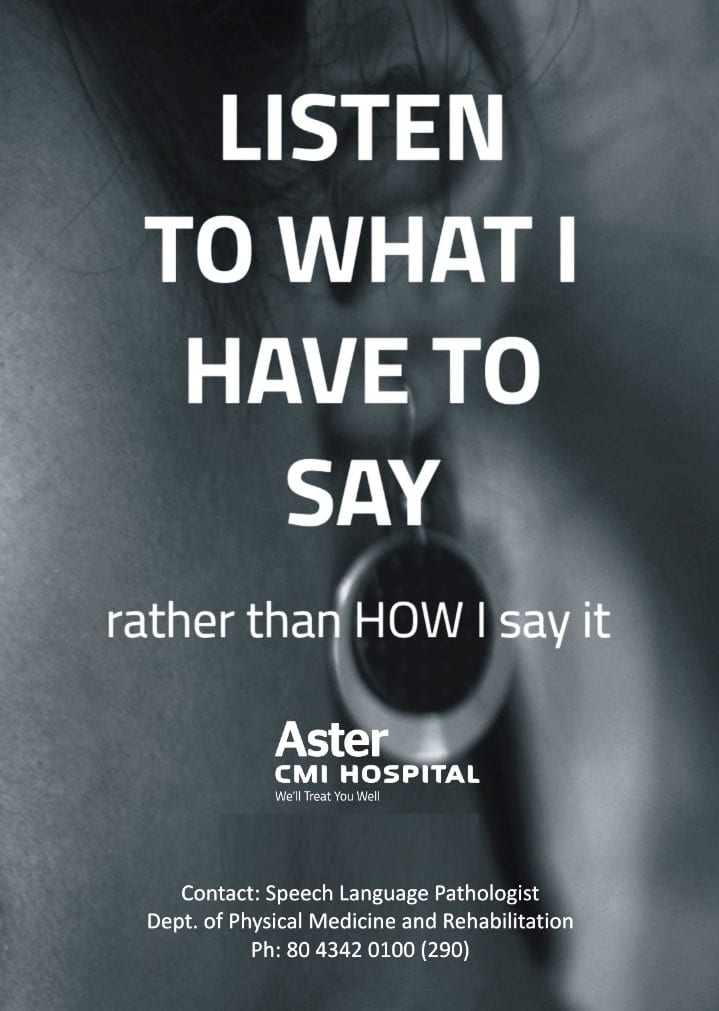@Life
INTERNATIONAL STUTTERING AWARENESS DAY 2019

–Growth through Speaking
Authored by Rekha D, Speech Language Pathologist, Department of Physical Medicine & Rehabilitation, Aster CMI Hospital, Bengaluru
“Communication – the human connection – is the key to personal and career growth/success”- Paul J Meyer.
Not a day goes by when we do not use verbal communication. In order to deliver the right information, one must be able to speak clearly and fluently. When a person has trouble speaking in a fluid, or flowing way, for example he/she may say the whole word or parts of the word more than once, or pause awkwardly between words. This is known as STUTTERING. We all have times when we do not speak smoothly. We may add “uh” or “you know” to what we say (for eg: “I um need to go home.”). Or, we may say a sound or word more than once (for eg: He is-he is my uncle). These dysfluencies are normal if they happen every once in a while. When it happens a lot, it may be stuttering.
The American Speech and Hearing Association (ASHA) defines stuttering as an interruption in the flow of speaking characterized by repetitions (sounds, syllables, words, phrases) (for e.g.: co-co-co-cookie), sound prolongations (for e.g.; cooooooooooookie), blocks (for e.g.: I want a …… cookie), interjections, and revisions, which may affect the rate and rhythm of speech.
Stuttering usually starts between 2 and 6 years old. Many children go through normal periods of dysfluency lasting for around 6 months. Dysfluencies lasting longer than this may need intervention. Stuttering can even be seen during adolescence or adulthood. There is no specific cause of stuttering, the probable causes are family history, being in contact with another stutter, imitation, brain differences, etc.
If your child or someone you know stutters, you should get help from a Speech-Language Pathologist (SLP), as early as possible. It is important to intervene children or adults with stuttering at the earliest, as it not only affect the way a person speaks but also nurtures feelings like fear, shame, avoidance, isolation anxiety, guilt etc. Hence early intervention has faster progress and helps to reduce its negative consequences.
October 22 was designated International Stuttering Awareness Day (ISAD) in 1998. The day is intended to raise public awareness of the millions of people – one percent of the world’s population who have the speech disorder of stuttering.
This year the theme being “GROWTH THROUGH SPEAKING” here are a few do’s and don’ts for parents, teachers and caregivers while speaking with a person with stuttering.
1.Don’t finish their sentences: as a parent or teacher or even a listener you might be tempted to finish their sentences in order to help them but this does more harm than good.
- Don’t look distressed or avoid eye contact:you need to let the person know by your manner that you are paying attention and listening to what they say rather how they say it.
- Don’t say, “Relax”, or “slowdown”:such simple advice can be demeaning to them.
- Don’t speak deliberately too slow or too fast:talking in a natural way promotes good communication model.
- Provide opportunity to talk:you need to give them an opportunity to speak without distractions from family members, class mates or friends.
- Be patient:give them enough time to talk for e.g.: give the person time to answer a question before you ask the second one.
- Beaware of their difficulties:persons with stuttering may have factors that aggravate their difficulty for e.g.: telephonic conversation, time pressure, unfamiliar listeners, fatigue or stress.
- Repeat or rephrase:you can repeat or rephrase what the person says that you have understood it.
The above mentioned guidelines will only help the person with stutters be comfortable while communicating, but in order to correct their dysfluencies they will require the help of a Speech Language Pathologist. Stuttering can be corrected at any age (earlier the better) with regular therapy by an SLP. An SLP can help by working with the child/adult to change how he/she speaks, on how to respond when the child/adult stutters, changes you can make to improve their fluency and what to do to improve how they feel about talking.
“Let us help all persons with stuttering grow out of their dysfluencies through speaking’’





































